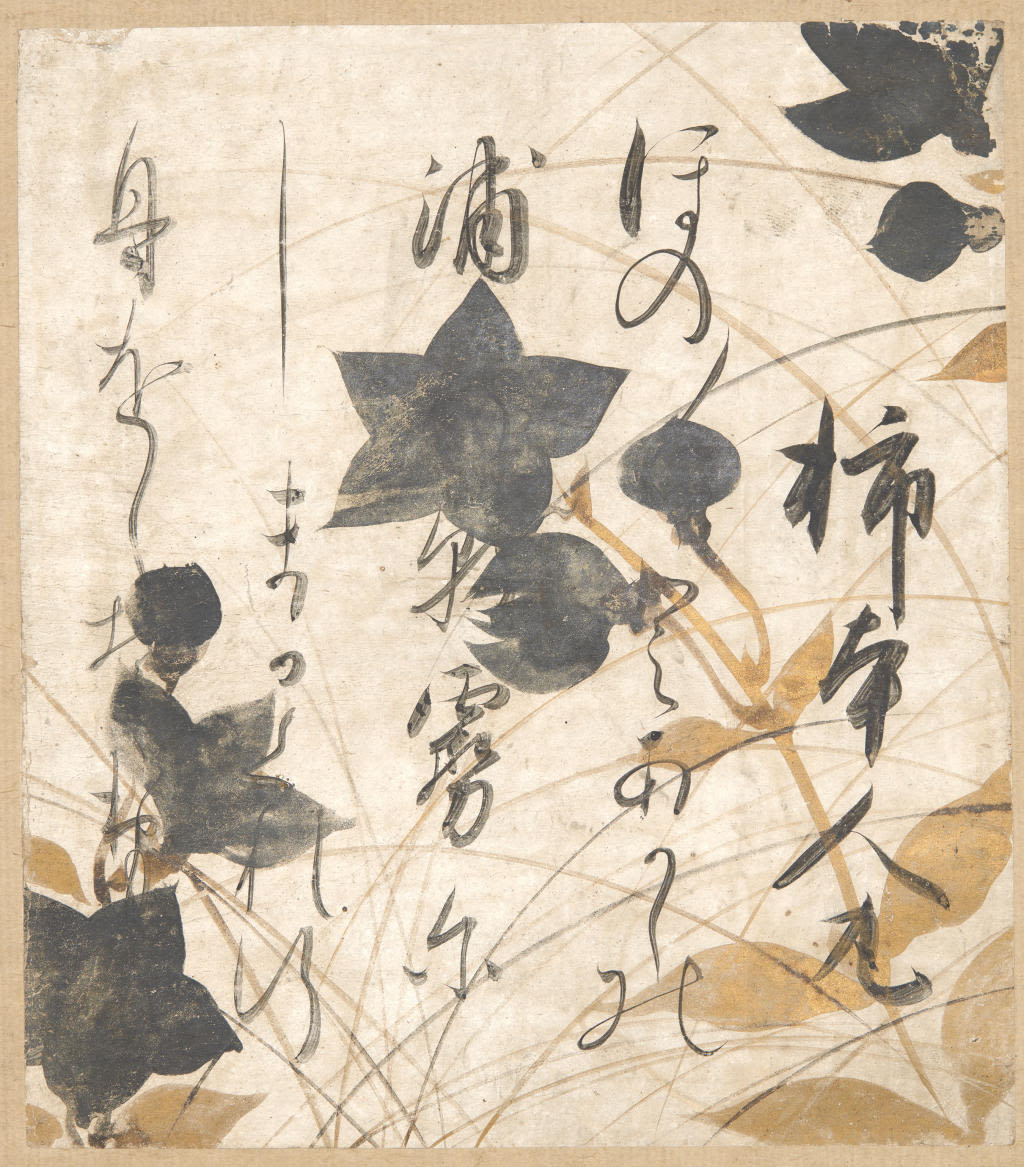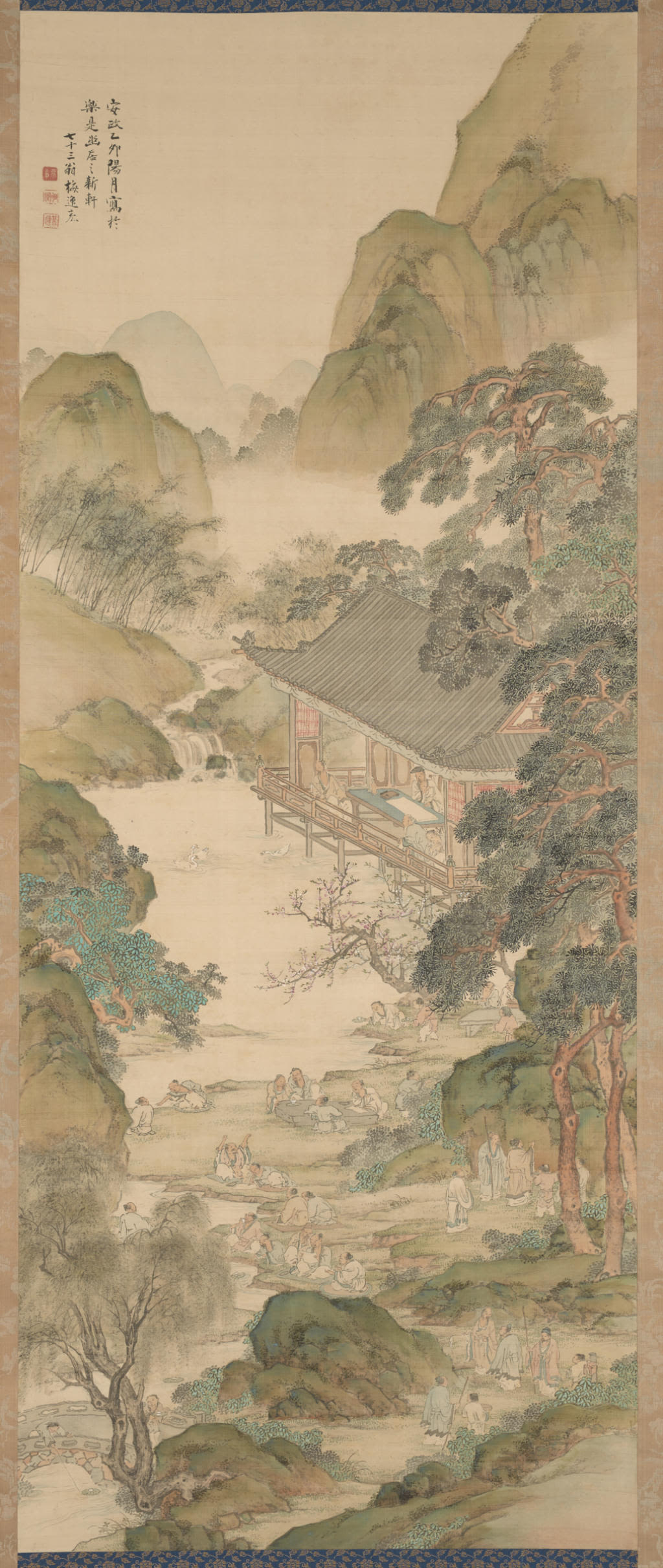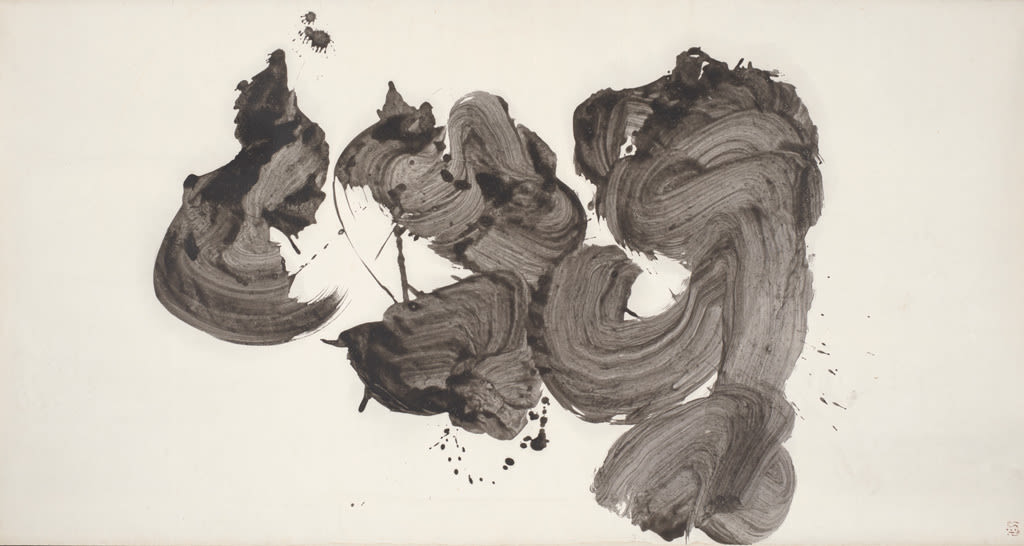Learn Why Poetry Lies at the Heart of Japanese Culture

Tōdaiji Scriptorium, Fragment of the Avatamsaka Sutra: The Nigatsudō Burnt Sutra, 744, handscroll fragment mounted as a hanging scroll; silver on indigo paper, 9 3/16 x 43 3/4 in.; mounting by Sugimoto Hiroshi (Japanese, born 1948), Collection of Mary and Cheney Cowles.
The earliest work in the exhibition, this is a fragment of a sacred Buddhist sacred text that was damaged by fire in the 17th century. The extravagance of the materials and the solemn, measured quality of the calligraphy, based on contemporary Chinese models, suits the nature of the text.
Since 1932, when the Portland Art Museum received the gift of the Mary Andrews Ladd collection of nearly 800 Japanese prints, the institution has been renowned for the depth and breadth of its collection of this popular medium. Since that time Japanese prints have taken center stage in a variety of exhibitions, and this fall Poetic Imagination in Japanese Art: Selections from the Collection of Mary and Cheney Cowles continues that tradition by offering visitors an extraordinary chance to see more than 100 paintings and works of calligraphy from one of the finest private collections of Japanese art in North America.
Poetry, painting, and calligraphy have always been deeply intertwined in East Asia, but in Japan the nature and meaning of those relationships have evolved over time, responding to larger cultural changes. The artworks in this exhibition, spanning the eighth to 20th centuries, illuminate the central role of poetry in the visual arts across time and in diverse social contexts.

Shōkadō Shōjō (Japanese, 1584–1639), calligraphy; Tawaraya Sōtatsu (Japanese, died 1643), painting, Waka Poem by Kakinomoto Hitomaro, early 17th century, shikishi mounted as a hanging scroll; ink on gold- and silver-decorated paper, 7 15/16 x 7 in., Collection of Mary and Cheney Cowles.
A younger contemporary of Emperor Goyōzei (see #6, above), Shōkadō Shōjō was considered one of the finest calligraphers of his time. Here he has brushed a famous poem on paper decorated by Tawaraya Sōtatsu, an equally famous artist known for creating a new style of decorative painting.
Formed over the past four decades, the collection of Mary and Cheney Cowles is exceptional in its quality and breadth, and unique in that it is deeply informed by classical Japanese taste as well as welcoming of idiosyncratic departures from the canon. Poetic Imagination in Japanese Art focuses on one of the great strengths of the Cowleses’ holdings: visual art closely tied to poetic traditions.

Yamamoto Baiitsu (Japanese,1783–1856), Orchid Pavilion in Blue and Green, 1855, hanging scroll; ink and color on silk, 56 1/4 x 22 5/8 in., Collection of Mary and Cheney Cowles.
Baiitsu’s subject here is the Orchid Pavilion Gathering, an event that took place in China in 353. Forty-some poets assembled to celebrate the Spring Purification Ceremony; wine cups were floated down a stream and, whenever one stopped, the man closest to it had to drink the wine and compose a verse. Baiitsu captures the lighthearted merriment of this famous gathering with his distinctive light touch.
“While those deeply familiar with Japanese culture will appreciate the literary allusions in these works, all visitors will be able to savor their evocative beauty,” says curator Maribeth Graybill, The Arlene and Harold Schnitzer Curator of Asian Art at the Portland Art Museum. “This is an exhibition that invites contemplative looking and emotional response. We hope that viewers will be inspired to compose their own verses about what they see and feel.”

Tomioka Tessai (Japanese, 1836–1924), Obsessions (detail), 1895, handscroll; ink and color on silk, 9 7/16 x 84 3/4 in., Collection of Mary and Cheney Cowles.
A scholar of Buddhist and Confucian texts, Tessai was mentored in his early career by the nun Rengetsu (see #12, above). His exuberant paintings are most often on Chinese themes. This image is a detail of a handscroll with imaginary portraits of eight Chinese literati known for their “obsessions,” such as calligraphy, books, or tea.
Visitors of all ages are invited to find poetic inspiration during three “Japanese Poetry, Art, and Culture Weekends.” These occasional special event weekends will feature demonstrations of calligraphy and ikebana—the Japanese art of flower arrangement—as well as music performances, poetry reading and writing opportunities, artmaking, and even the chance to sample Japanese small bites and sweets from local makers. Partners, performers, and vendors include snacks from Beaverton-based Oyatsupan Bakery; poetry writing, reading, display with Write Around Portland; origami demonstration and art making with Yuki Origami (Yuki Martin); and calligraphy demonstrations with Sora Shodo.

Inoue Yūichi (Japanese, 1916–1985), Shout, 1961, hanging scroll; frozen ink on paper, 37 x 69 5/16 in., Collection of Mary and Cheney Cowles.
One of the most celebrated Japanese artists of the post-war period, Inoue Yūichi infuses the traditional art of calligraphy with the sensibility of abstract expressionism. The text here is the Japanese word katsu!, which is the shout of a Zen master when he strikes a student who is dozing off.
Additionally every Thursday morning there will be a public Ikebana demonstration in partnership with the Portland chapter of Ikebana International.
Japanese Poetry, Art and Culture Weekends
October 19, 5 – 8 p.m. (admission $5 after 5 p.m.)
October 20, 11 a.m. – 3 p.m. (regular admission pricing)
November 16, 5 – 8 p.m. (admission $5 after 5 p.m.)
November 17, 10 a.m. – 5 p.m. (FREE admission as part of Miller Family Free Day)
January 11, 5 – 8 p.m. (admission $5 after 5 p.m.)
January 12, 11am-3pm (regular admission pricing)
Children under 17 years old are always free.
